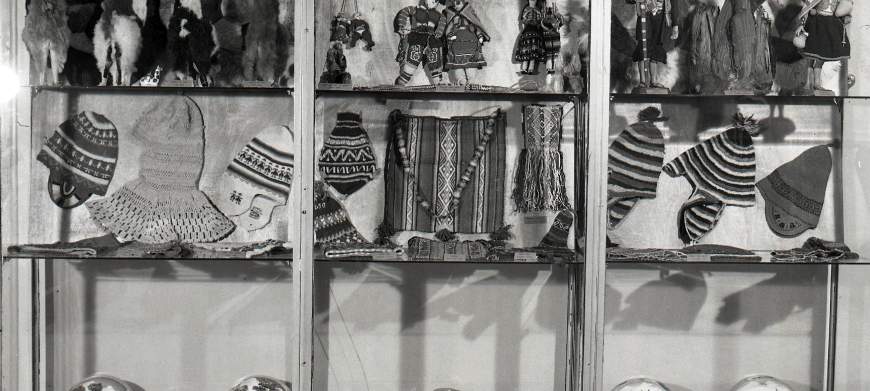The history of the current Museu Etnològic i de Cultures del Món dates back to the 20th century, with the creation of two independent museums: the Museu d’Indústries i Arts Populars (1942) and the Museu Etnològic i Colonial (1949). These two museums played a leading role in the study and fostering of ethnology.
Located in Poble Espanyol, the Museu d’Indústries i Arts Populars was dedicated to Catalan and Iberian Peninsula culture, in its Pyrenean variant, and its collections were focused on trades, traditions and everyday life. The museum had an ethnological section designed by Ramon Violant i Simorra. At first, this area included some items from the Archaeological Museum's ethnological section, created by the director of the Barcelona City Archive, Agustí Duran i Sanpere, and the ethnologist Joan Amades.
Founded in 1948, after approval by the Full City Council of 26 October of the same year, the Museu Etnològic i Colonial was inaugurated in 1949, in an old pavilion in Montjuïc, built for the Universal Exposition of 1929. Although the museum's collections mostly came from other city museums, they grew larger thanks to various expedicions etnologicoantropològiques undertaken around the world until the 1960s (in 1979 Barcelona City Council withdrew funding for acquisitions made abroad). Unlike the Museu d’Indústries i Arts Populars, the objective of the Museu Etnològic i Colonial, dedicated to general ethnology, was to house collections of material culture from around the world.
In 1962, the Museu d’Indústries i Arts Populars and the Museu Etnològic i Colonial merged into a single museum, under the direction of August Panyella. The merger of the two museums’ lines resulted in a global perspective of ethnology, which included the aspects closest to home and those from far away.
In 1973 the Museu Etnològic was inaugurated in Passeig de Santa Madrona, 16-22, in a building constructed expressly to house the museum. August Panyella, the first director of the Museu Etnològic, who had first-hand knowledge of the museum's collections and needs, collaborated in the construction of the building, along with his team.

Between 1962 and 1999, the two museums went through a series of mergers and separations. They separated again in 1982, and they were joined by the Museu d’Arts Gràfiques, located in the Poble Espanyol site.
It wasn't until 1999 that they merged definitively. They then became a single museum with a collection of materials from all over the world, including Europe (areas of Austria, Spain, Greece, Portugal and Turkey), consisting of around 70,000 items.
In 2011 an agreement was signed with the Folch Foundation to include, on loan, a large set of non-European items from its collection. The Folch Foundation pieces conserved and exhibited in the Museu Etnològic i de Cultures del Món are from the same time period as the museum's own pieces and, in many cases, come from the same expeditions. They are therefore items that share common origins and scientific criteria.
In 2012 it was decided to expand the Museum’s non-European collections and house them in a new space.
In 2015, the creation of the Museu de les Cultures del Món in the neighbourhood of La Ribera was formalised, more specifically at no. 12 Carrer de Montcada, on the site formed by the Nadal and Marquès de Llió manor houses. The Centre's mission: to provide the general public with a selection of publicly and privately owned exhibits from various cultures native to Africa, Oceania, Asia and the Americas.
In 2017, the Museu Etnològic and the Museu de Cultures del Món became a single museum, the Museu Etnològic i de Cultures del Món, with two facilities: the Parc Montjuïc Venue, in the Museu Etnològic building inaugurated in 1973 and reopened in 2015 after a four-year renovation, and the Montcada Venue, located in the Nadal i Marquès de Llió manor houses, which were renovated specifically to create this preservation, dissemination and social projection facility.